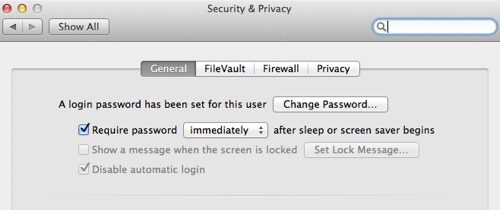Posts for October 2013
Why technology is essential to compete internationally

Technology has changed how we do business. But does increasing use of tools like cloud computing make it easier for businesses to grow and compete on the global stage?
In a recent study (PDF link) by Oxford Economics, sponsored by SAP, 2,100 small businesses over 21 countries were surveyed to see how they use technology to improve operations and compete globally.
It reveals small companies use cloud computing, business management software, data analytics, mobile, and social media to drive change within their businesses. 59% of respondents said technology enables them to compete in more locations than in the past.
And with nearly 60% of companies saying they've noticed an increase in foreign competition over the last two years, being able to compete globally is becoming a necessity.
Tech opens doors for your business
But technology doesn't just make it easier to compete with other businesses. It also opens the gateway to networking and collaboration. Of the businesses questioned, 40% have used online platforms to form strategic partnerships outside their home markets.
Some of those partnerships are initiated via social media. Indeed, 35% of companies questioned are utilising social media to source, market and connect directly with their target audiences. Interactive content and social sharing are cheap, effective forms of marketing.
You need to stay informed
Technology is constantly evolving, but companies that are not informed about new tech are reluctant to implement services that could ultimately benefit them. In the research, 32% suggested that they struggle to understand how technology can improve their business.
As technology advances, you must regard its implementation and management as an ongoing process. If you want to grow your business, you must be prepared to use the tools that will enable you to compete in a global economy.
Sara Parker blogs for Face for Business, a fast-growing company that provides call answering services for SMEs across the UK.
Do you have a 'worliday' mentality?

Nobody ever works like this on their holiday.
Having just returned from a holiday during which my smart phone and laptop accompanied me, it's interesting to read research that says nearly two-thirds of British small business owners are likely to use their mobile devices for work purposes when off work.
The research, carried out by YouGov on behalf of FreeAgent, found 62% of people who run small businesses with five or fewer employees are either 'very likely' or 'fairly likely' to access their mobile devices for work when they take time off.
FreeAgent reckons the results may suggest small business owners are increasingly adopting a 'worliday' mentality, where they combine work and vacation to keep in touch with important aspects of their business. (It's unclear why they've adopted the horrendous portmanteau of 'worliday' — I prefer the much more elegant 'holidork'.)
Freelancers are always on duty
As a freelancer, these findings chime with my own experiences. Because I work by myself, there's nobody else to answer urgent emails or reply to new business enquiries when I'm away. As a result, I make a point of monitoring my email and replying to important messages.
However, it's not healthy to be immersed in work, so I make a conscious effort to limit the time I spend online while on vacation. This means I don't do any work other than replying to emails. And if I think a reply can wait till I get home, it does.
Choosing not to switch off
"Our research shows that there are a lot of small business owners who choose not to ‘switch off’ when they go on holiday, but that’s not necessarily bad news," reckons Ed Molyneux, CEO of FreeAgent. "For some of them, staying connected is actually likely to be an important way for them to keep on top of their business and ensure everything is in order, so they can actually take a vacation in the first place."
So, although technology often gets a bad rap for making it hard for us to switch off from work, there's a positive side too. If it weren't for the magic of smart phones and mobile connectivity, many people wouldn't feel able to go on holiday in the first place. Me included.
Friday tech tip: run apps side-by-side in Windows 8
Microsoft's Windows 8 is very different to previous versions. Designed to work both on tablet touch screens and standard computers, it takes a bit of getting used to.
One of the major differences is that many apps are designed to be run full-screen, so you can't see any other programs at the same time. This is great for helping you focus, but rubbish if you need to refer to another app too.
Show apps side-by-side
For this week's Friday tech tip, we explain how to show two apps side-by-side in Windows 8. It's really straightforward:
- Open the first app you want to use.
- With the app on your screen, click and hold at the top, then drag down.
- The app should shrink in size, allowing you to drag it around.
- Keep holding the mouse button and drag the app to the left or right of the screen.
- Release the mouse button and the app will snap to the side you dragged it to.
- Now go back to your start screen by clicking in the bottom left corner.
- Open the second app you want to use.
- It will appear side-by-side with the first app, so you can see both at once.
To change how much of the screen each app takes up, click and drag the bar that sits in between the two apps.
This video from website WinBeta shows the snap feature in action:
- Three (increasingly severe) ways to reduce your printing costs
- How to lock your Mac while away from your desk
- Save time and find things faster with CTRL + F
Get an IT security healthcheck
 We cover IT security a lot on this blog, because it’s a really important subject and there’s a lot to say about it.
We cover IT security a lot on this blog, because it’s a really important subject and there’s a lot to say about it.
Unfortunately, that means it’s difficult to stay on top of current security threats, like knowing whether you should be more worried about hackers or viruses this week.
If you feel like you haven’t given any thought to data and IT security lately, we’ve found a security healthcheck tool that you might find useful.
Created by AVG, a company that makes security software, it asks you a number of questions before scoring your security overall and providing specific advice in each area.
It’s not a magic solution to keeping your data safe. IT security is different for every business, so you still need to learn more about the dangers you may face and speak to your IT supplier to make sure you’ve taken sufficient precautions.
However, this tool will get you thinking about the things that matter when it comes to IT security. And the advice at the end should give you some good starting points for improvements.
Just bear in mind that this advice is purely from a security perspective.
For instance, while the tool may advise you to upgrade to the latest version of Windows (and that might be the most secure option), there are other considerations too, like whether your existing software will keep working ok.
We also have lots of other information to help you secure your business IT systems. These are some good places to start:
How to cope in a world that's gone beyond information overload
 Americans consumed about 3.6 zettabytes of information in 2008. You can bet the UK isn’t far behind.
Americans consumed about 3.6 zettabytes of information in 2008. You can bet the UK isn’t far behind.
That’s an enormous volume of information: the difference between 0.3 and 3.6 zettabytes is ten times the number of grains of sand on the earth.
This volume of information is apparent every day, in our bulging inboxes, our enormous choice of TV channels and an endless list of results on Google.
It’s no longer information overload. It’s filter failure.
Chaos on the information superhighway
There is chaos on the information superhighway. We can't see the wood from the trees. Facts do not exist any more, because every fact has an anti-fact on the web.
We create our own belief bubbles, our brains are mush and we are driven by what the smart phone tells us. It’s a cocktail for disaster. Or is it?
There’s nothing to worry about
In Smarter than you think: how technology is changing our minds for the better, author Clive Thompson talks about how technology and the internet makes us smarter and better.
His argument is convincing. Technology provides eternal memory, where we can recall anything and learn from it. And it creates cognitive diversity, providing a place to test, discuss and distribute our thinking with all knowledge at our fingertips.
Technology has also made us more literate. We are writing and reading more than ever with texts, emails, tweets and so on, but tech is also creating different types of literacy.
With video, images, data and — soon — 3D printing, the internet and technology is giving us more rich ways to express ourselves.
Constant distractions
If you put it that way, it is difficult to argue. However, Thompson does make reference to the fear of missing out (FOMO) syndrome, the dangers of constant distraction and the need to be mindful and aware of how you think.
And that brings me to Daniel Kahneman’s Thinking, fast and slow. His advice? Regularly step out of this stream of digital information. Take time to slow down. Meditate. Relax.
Kahneman thinks that, in future, we may all benefit from our own digital assistants. He cites Watson, the supercomputer that can play guess-the-question quiz show Jeopardy.
The technology behind Watson is now being used to help doctors diagnose patients based on the answers they give.
In five years, you could have Watson on your phone. It will be your digital, ambient, super-smart digital assistant who can help with your memory, knowledge, thinking and a lot more.
And what will happen then? Well, once you have a powerful new tool for finding answers, you can think of harder problems to solve.
- Are we using technology, or is it using us?
- Coping with increased data storage needs
- Tech that could change your business sooner than you think
Ron Immink is CEO of Book Buzz and a contributor to Small Business Can.
Friday tech tip: three (increasingly severe) ways to reduce your printing costs

Look at it: every page a waste of money
Printing stuff out is expensive. You can spend a fortune on ink, toner and paper — not to mention the cost of buying the printer in the first place and getting it seen to when it (inevitably) goes wrong.
With research in 2010 finding that each employee in Europe prints an average of 31 pages a day, we don't blame you if you're trying to cut your printing costs. And for this Friday's tech tip, here are three options — from the obvious to the controversial:
1. Go double-sided, draft and greyscale
If you've ever investigated your printing costs before, you'll probably have done these three things already. If not, they can have a big impact on printing costs and waste.
For a start, make sure your printer is set to print in double-sided mode. This is sometimes called duplex printing, because printer companies love their jargon.
Also, find the draft setting and turn it on by default — this will use a lot less ink or toner, at the price of print quality that's ever so slightly worse than normal.
Finally, make sure your staff don't print in colour when they don't need to by setting the printer to greyscale.
(Incidentally, if you're in the market for a new printer, make sure you spend the extra for one that does double-sized printing as standard, without requiring you to turn the paper over manually. It's worth the extra expense.)
2. Implement a smart card system
Increasingly, companies are using smart printing systems to manage, track and control who prints what.
This usually means that once an employee has sent a document to the printer, they then have to walk to the printer and swipe their individual smart card to retrieve their printed document.
As well as reducing your overall costs and letting you track who prints what, this system should put an end to unwanted printouts lying on the printer.
3. Ban printing altogether
If your company has a chronic printing problem, it could be time to play hard ball by banning printing on certain days each week.
Think carefully before enforcing this though. It may be impractical to expect some employees to print nothing, even if it's just for a day.
I also once worked for a company that confiscated the printer power cables in an effort to restrict printing. Going by the amount of grumbling that took place that day, I think it's likely the resulting productivity dip more than neutralised any cost savings.
What's next after tablet computers?
 Sales of tablet computers have risen and analysts at IDC predict that the final quarter of 2014 will see their sales outnumber those of PCs.
Sales of tablet computers have risen and analysts at IDC predict that the final quarter of 2014 will see their sales outnumber those of PCs.
That figure suggests the post-PC era is either looming quickly or already here. It also raises another question for anyone who likes looking ahead: what’s next?
The tech giants, Samsung and Google, appear to reckon that the next era is going to be about wearable tech. Samsung has just released its Galaxy Gear watch, while Google has Glass, a high-tech pair of glasses.
Give it another ten years or so, and — although we might not quite be cyborgs — there’s a good chance you’ll be sporting technology that knows a lot about you and where you are.
It’s all about context
The next generation of mobile devices will be both wearable and contextual.
Actually, contextual technology is already widely available. Google Now is a prime example. It displays information based on your location, search history, the time of day and so on.
In the future, Google Glass seems likely to provide the wearable aspect, incorporating contextual information into its user experience.
Glass will have to overcome a few social barriers to succeed, but if Google can manage that then we’ll see an explosion of services than utilise information from a user. With ubiquitous, wearable computing looming, the race has only just begun.
Are we heading for immortality?
The post-tablet era may not be hitting the mainstream yet, but the signs are pointing in a clear direction. It’s going to be all about the combination of wearable technology and contextual information.
Watching how the big players spend money and where they make early investments can give us a view of the way they expect the technology sector to go. It’s hard to know if they’re right or not, but would you bet against Google’s track record?
- Ok Glass, let’s revitalise the High Street
- What does 2013 hold for mobile computing?
- Are we using technology, or is it using us?
Shawn Hunt runs Satellite Broadband UK, delivering fast, reliable two-way satellite broadband services.
How the cloud changes your business IT
 The term cloud computing has been around for years now. The idea itself goes back even further.
The term cloud computing has been around for years now. The idea itself goes back even further.
However, there are still plenty of businesses that haven’t yet considered using cloud computing as part of their IT. There are plenty more that use the cloud without realising it, or that simply aren’t clear on the impact of the cloud.
(Confused about the cloud? Read our simple introduction to cloud computing.)
Here’s a quick five-point guide to the key ways cloud computing could change how your business operates its IT:
- More manageable spending. Although it’s not always the case that the cloud saves you money, cloud computing does make your IT costs more predictable and manageable, because you pay by the month instead of having to make big one-off payments for hardware or software.
- IT as a single entity. Cloud services blur the line between software and hardware, because often you’ll pay by the month to access a service (the ‘software’) running on a server owned by the cloud provider (the ‘hardware’).
- New job descriptions. Cloud computing services often include maintenance and support, so the job roles of your IT staff can change dramatically. They need to understand the implications of the cloud and how to integrate new services with your current systems.
- Mobile working as standard. Cloud services come all ready for remote working. Because they sit outside your business, accessing them is the same no matter whether you’re on your premises or not. The cloud can really simplify remote, mobile and flexible working.
- Different security issues. Cloud providers usually have very high standards of security, because they’re specialists and their whole business depends on maintaining security. However, the cloud can change the security challenge your business faces.
If you’ve introduced cloud computing to your business, have you seen these changes? What would you say to other businesses considering a similar move?
- Essential cloud computing services
- Is the cloud right for you?
- Are businesses really flocking to the cloud?
Russell Scott is Managing Director of Sycura, a firm offering cloud computing solutions and IT support in the Hertfordshire area.
Friday tech tip: lock your Mac when away from your desk

It's good to lock your computer when you're away from your desk. This stops people sneaking a peek at sensitive files, using your computer without your knowledge, or simply messing with your desktop wallpaper for comedy value.
On a Windows PC, most people know that they can lock their system by pressing CTRL + ALT + DELETE, or by simply hitting the Windows key and L together.
As the key combination on a Mac isn't so well known, for this Friday's tech tip we thought we'd explain it.
Check your preferences first
In order to lock your Mac effectively, you first need to ensure that your system is set up to request a password after it's gone to sleep:
- Open your System Preferences by clicking the cogs on your Mac's dock at the bottom of the screen.
- Select Security & Privacy, then General.
- Make sure there's a tick in the box that says Require password after sleep or screen saver begins (see image, above).
- Click the red cross (top left) to close your preferences.
Next hit the shortcut
Your Mac will now request your password each time you put it to sleep. This creates the same effect as locking a Windows computer.
All you need to do now is to learn the quick shortcut to put your Mac to sleep:
- If your keyboard has an eject button at the top right, press CTRL + SHIFT + EJECT
- If your keyboard doesn't have an eject button, press CTRL + SHIFT + POWER
Your Mac will go to sleep instantly, but don't be alarmed. You can hit any key to wake it up, pop in your password and then everything will be there as you left it.
49 of the UK's top 50 retailers don't have responsive websites

Responsive websites adapt to fit different screens.
According to IDC's worldwide and US tablet forecast, 2013 will be the first year in which more tablet computers are sold than traditional PCs. But although consumers are increasingly using smaller screens to view websites and buy online, online retailers are lagging behind with their websites.
Digital solutions provider Venda analysed websites from the top 50 e-retailers as defined by IMRG and Experian (admittedly, this list is a couple of years old).
The results are quite striking. It found that only one of these retailers uses responsive web design to create a site that automatically adapts itself to different screen sizes. The retailer in question is Currys.
Make mobile shopping easier
Given that a third of all UK page views now come from smart phones and tablets, delivering a good user experience across all devices should be top priority for anyone looking to sell online.
Responsive web design isn't the only way to do that. Many businesses run a completely separate mobile website, designed specifically for small smart phone screens. Some also have mobile apps to help you search and buy items quickly.
Both these approaches are fine, but neither makes good use of screen sizes that fall in between smart phones and desktop computers. The great thing about responsive sites is that they're fluid, and designed to work on any screen, rather than those of specific sizes.
The argument for going responsive
If you've not given much thought to the experience mobile users have on your business website, now really is the time to start. You'll find that the argument in favour of a responsive approach is strong.
Responsive design is the best way to create a consistent user experience, no matter what device people are viewing your website on. The content on the pages remains fundamentally the same, but just displays differently.
This means that you don't have to find a way of identifying mobile users in order to show them a different website, or worry about redirecting URLs so people see relevant information on both versions of your website.
When people share links to your website, you'll also know that the pages will always be optimised for the viewing device, not the device the link was shared from.
Quite simply, responsive web design is the only way to cater for the ever-expanding range of devices that people are using to access the internet. It's time to start making our sites more flexible.
Three great mobile apps to get you organised
You've never had it better when it comes to managing and saving time in your business, no matter whether you're in the office or not.
Why? It’s all thanks to the smart phone, or at least the app stores that are giving mobile developers a way to get their productivity apps out there.
You don't have to rely on the basic functions of your phone to make you more productive. Apps are big business for app studios around the world and the intense competition creates some superbly innovative tools that you can take advantage of.
Here are three brilliant apps — available for Android or Apple iOS — designed to help you manage and save time.
1. Wunderlist 2

Wunderlist was a hit. Now Wunderlist 2 makes it easy to create, organise and share your to-do lists.
The reason it has so many fans is because it allows you to create subtasks within tasks, which makes organising projects is a breeze.
Visit the Wunderlist 2 website >>
2. Checkmark

Checkmark is a visual list-making tool that wants to make all your tasks easier to complete and remember.
The thing that makes it a bit different to other task apps is that it's location-based, which means you can, for instance, create a reminder to go off 15 minutes after you get into work.
It's perfect for getting you to remember tasks like dropping the post off on your way home, calling a client when you reach a certain location or dropping in on a supplier when you're in the area.
Visit the Checkmark website >>
3. Flipboard

Flipboard is a content aggregator that takes all your usual RSS feeds, Twitter and Facebook accounts and puts them into one place.
But that's barely scratching the surface of what you can actually do with Flipboard. The biggest time-saving feature is that you can quickly flip through each story on your board and see the first paragraph, allowing you to check key information and news sources faster.
You can also combine sources to create what Flipboard calls magazines, and you can subscribe to magazines that other users have created too.
Visit the Flipboard website >>
This is a guest post from Adam Stevens on behalf of 1st Rate, a business telephone systems provider.
Friday tech tip: save time and find things faster with CTRL + F

Sometimes it's the simplest IT tips that can save you most time. So, for this week's Friday tech tip, we've identified a simple shortcut that'll help you find what you're looking for more quickly.
It works in almost every application, but it's particularly useful when you're looking for information on a lengthy web page, in a Microsoft Excel spreadsheet or Word document.
Instead of scrolling through pages of text and figures to find the thing you need, hit this easy shortcut:
CTRL + F
(That means hold down the CTRL key, tap the F key, then release the CTRL key. If you use a Mac, hit CMD + F instead.)
In almost every major piece of software on your computer, a 'find' box will appear or pop up. Just enter in some text to identify what you're looking for, and hit the Enter key. The display on screen will highlight where that text appears.
This simple time saver is one I use several times a day. Once you become accustomed to it, you'll be using it to make life easier in all kinds of circumstances.
Will fingerprints be the passwords of the future?

Apple's iPhone 5s has one particularly striking new feature. There's a fingerprint reader built into the phone's home button, which means you can unlock the phone and authorise purchases using your fingerprint instead of having to tap in a code or password.
As with many of Apple's apparent innovations, this has been done before. Motorola's ATRIX handset has a fingerprint scanner and that launched in 2011. The only problem was reviews found it to be unreliable.
Easier than passwords
First impressions of the iPhone's fingerprint scanner, on the other hand, suggest that it works very well. If it proves reliable over time, then the new iPhone could be the first in a wave of products that bring fingerprint recognition to the masses.
At face value, this is A Good Thing. Who hasn't struggled to recall an impossible-to-remember password at some point or other? As we've said before on this very blog, 'passwords are fundamentally broken'.
Are fingerprints secure?
Before we start using fingerprints for everything from mobile phones to internet banking, some experts reckon it would be an idea to think through the implications in a little more detail. After all, your fingerprint is very different to a password because it can't be changed.
Data protection expert Johannes Caspar put it well in a recent article for German newspaper Der Speigel:
"The biometric features of your body, like your fingerprints, cannot be erased or deleted. They stay with you until the end of your life and stay constant — they cannot be changed. One should thus avoid using biometric ID technologies for non-vital or casual everyday uses like turning on a smartphone."
In short, your fingerprint is a one-shot deal. Once it's compromised, that's it.
As if to back up his point, a hacker club already claims it's managed to fool the iPhone's fingerprint reader by taking a photo of a fingerprint and using it to create a fake finger.
But if that's the case, surely it's silly to rely on fingerprints to provide any sort of meaningful protection at all. Using a fingerprint to authorise a bank transfer? Forget it. Controlling building access via fingerprints alone? Probably a no-go.
Then — of course — there are other fringe concerns about relying on fingerprints. The Daily Mail (who else?) warns iPhone thieves might start lopping off people's fingers. And what do you do if you've hurt a finger (pictured)?
Convenience trumps security
Ultimately, the arguments over the stength of fingerprint-based systems are likely to be trumped by the convenience factor. If using your finger to unlock your phone is easier and faster than tapping in a code then people will use it.
It's unlikely fingerprints will ever be used for authentication in more critical circumstances except when combined with something else. This 'two-factor' authentication usually requires something you have (your fingerprint) and something you know (perhaps a password or PIN).
So, get ready: the fingerprint revolution is on the way.



